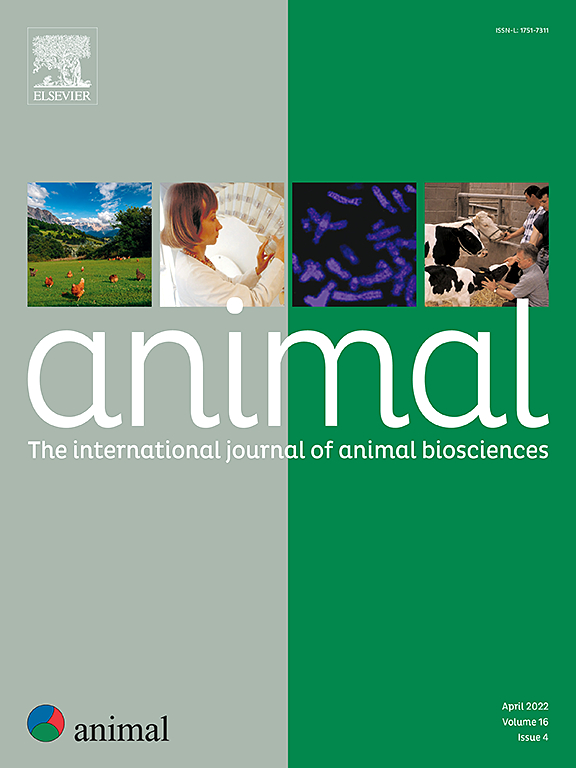Towards an industry-wide, multilevel evaluation framework for pig meat inspection: potential applications and implementation challenges
IF 4.2
2区 农林科学
Q1 AGRICULTURE, DAIRY & ANIMAL SCIENCE
引用次数: 0
Abstract
Meat inspection (MI) data can be useful as a monitoring tool of animal health and welfare on farm, thereby enhancing the sustainability and productivity of livestock. There is also concern about certain limitations of these data, primarily related to the quality and harmonisation of inspections across various slaughterhouses. In our study, we investigated the development of a cross-slaughterhouse ranking system for farmers using MI data. The integration of new digital tools in Germany, such as the web-based database Qualifood®, offers new opportunities for collecting and utilising MI data across different slaughterhouses, enabling at the same time digital feedback of these information to livestock farmers. To accomplish our research goal, MI data over a period of 5 years (2020–2024) was exported from Qualifood®. Our analysis was conducted using MI data from both cattle and pig farms. However, this manuscript focuses on presenting the statistical analysis model using pig data and the category “respiratory health” as a representative case study. We presented an annual overview of reference values -the so-called basic risk- for respiratory health findings using generalised linear mixed models. The basic risk of respiratory health findings for pigs showed a gradual decline from 14.4% in 2020 to approximately 12.0% in 2024. The calculated basic risks establish a reference for normal finding rates and provide a baseline assessment of respiratory health in southern Germany based on MI data. Furthermore, we estimated the variability of key random effects derived. Across all years, SDs for farm and delivery levels remain relatively stable between the selected and full datasets, indicating consistent variability at these levels. However, the slaughterhouse-level SDs are substantially higher in the full dataset compared to the selected slaughterhouses suggesting notable heterogeneity in reporting or detection practices across facilities. This underlines the importance of slaughterhouse selection when conducting cross-facility analyses and benchmarking. Towards a cross-slaughterhouse evaluation, we compare the farmer-specific risks and the basic risk using the concept of relative risk, also known as risk ratio. Our model demonstrates how recent advancements in digitalisation enable the evaluation of MI data across multiple slaughterhouses, underscoring the importance of region-wide, digital, and standardised MI data collection as a foundation for consistent and reliable cross-slaughterhouse assessments. By addressing inconsistencies in recording quality, our model can support a data-driven decision-making for farmers, industry stakeholders, and veterinary authorities, ultimately reinforcing the entire agricultural value chain and animal health and welfare management.
面向全行业、多层次的猪肉检验评估框架:潜在的应用和实施挑战
肉类检验数据可作为监测农场动物健康和福利的有用工具,从而提高牲畜的可持续性和生产力。人们还担心这些数据的某些局限性,主要与各屠宰场检查的质量和协调有关。在我们的研究中,我们调查了使用MI数据为农民开发的交叉屠宰场排名系统。德国整合了新的数字工具,如基于网络的数据库Qualifood®,为收集和利用不同屠宰场的MI数据提供了新的机会,同时能够向畜牧农民提供这些信息的数字反馈。为了实现我们的研究目标,从Qualifood®导出了5年(2020-2024)的MI数据。我们的分析是使用牛场和猪场的MI数据进行的。然而,本文重点介绍了以猪数据和“呼吸健康”类别为代表的案例研究的统计分析模型。我们提出了参考值的年度概述-所谓的基本风险-呼吸系统健康研究结果使用广义线性混合模型。猪呼吸道健康的基本风险从2020年的14.4%逐渐下降到2024年的12.0%左右。计算出的基本风险为正常发现率建立了参考,并根据心肌梗死数据提供了德国南部呼吸健康的基线评估。此外,我们估计了关键随机效应的可变性。在所有年份中,农场和交付水平的SDs在选定数据集和完整数据集之间保持相对稳定,表明这些水平具有一致的可变性。然而,与选定的屠宰场相比,整个数据集中屠宰场级别的SDs要高得多,这表明跨设施的报告或检测实践存在显著的异质性。这强调了在进行跨设施分析和基准测试时选择屠宰场的重要性。对于交叉屠宰场的评估,我们使用相对风险(也称为风险比)的概念来比较农民特定风险和基本风险。我们的模型展示了数字化的最新进展如何使跨多个屠宰场的MI数据评估成为可能,强调了区域范围内,数字化和标准化的MI数据收集作为一致和可靠的跨屠宰场评估基础的重要性。通过解决记录质量不一致的问题,我们的模型可以为农民、行业利益相关者和兽医当局提供数据驱动的决策支持,最终加强整个农业价值链和动物健康与福利管理。
本文章由计算机程序翻译,如有差异,请以英文原文为准。
求助全文
约1分钟内获得全文
求助全文
来源期刊

Animal
农林科学-奶制品与动物科学
CiteScore
7.50
自引率
2.80%
发文量
246
审稿时长
3 months
期刊介绍:
Editorial board
animal attracts the best research in animal biology and animal systems from across the spectrum of the agricultural, biomedical, and environmental sciences. It is the central element in an exciting collaboration between the British Society of Animal Science (BSAS), Institut National de la Recherche Agronomique (INRA) and the European Federation of Animal Science (EAAP) and represents a merging of three scientific journals: Animal Science; Animal Research; Reproduction, Nutrition, Development. animal publishes original cutting-edge research, ''hot'' topics and horizon-scanning reviews on animal-related aspects of the life sciences at the molecular, cellular, organ, whole animal and production system levels. The main subject areas include: breeding and genetics; nutrition; physiology and functional biology of systems; behaviour, health and welfare; farming systems, environmental impact and climate change; product quality, human health and well-being. Animal models and papers dealing with the integration of research between these topics and their impact on the environment and people are particularly welcome.
 求助内容:
求助内容: 应助结果提醒方式:
应助结果提醒方式:


